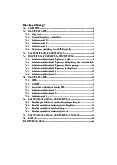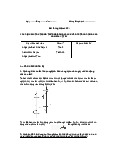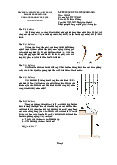




Preview text:
International Research Journal of Engineering and Technology (IRJET) e-ISSN: 2395 -0056
Volume: 04 Issue: 05 | May -2017 www.irjet.net p-ISSN: 2395-0072
Stress Analysis of Piston a
t Different Pressure Load
Mr. Sanket R. Jayale1, Prof. G.
A. Kadam2, Mr. Umar Pathan3
1 PG Student, Department of Mechanical Engineering, SKNSITS, Lonavala, India
2 Professor, Department of Mechanical Engineering, SKNSITS, Lonavala, India
3Senior Design Engineer, Microine Engineering, Bhosari, Pune
---------------------------------------------------------------------** -
* --------------------------------------------------------------------
Abstract - Internal combustion engines have been, and
To determine the maximum stress and critical
will remain for the foreseeable future, a vital and active area
region on the aluminum alloy piston by using Finite
of engineering education and research. Most of the researches Element Method.
in internal combustion engines are operating performance
To determine the stress distribution of Cast Iron
and fuel performance oriented. Every mechanical component
piston by using Finite Element Method.
is designed for a particular structural and thermal strength.
To determine the maximum stress and critical
Piston seizure and cylinder block melting are typical problems
region on the Cast Iron piston by using Finite
when thermal and structural loads on the components exceed Element Method.
the design strengths. Piston is a cylindrical component itted
into the cylinder and forms the moving boundary of the
combustion system. It its perfectly into the cylinder providing 1.2 SCOPE
gas tight space with the help of piston rings and lubricant.
These pistons are made of two different types of materials
The result of this work could be useful for the
aluminum alloy and cast iron. Structural and thermal analysis
design of the piston which bears the pressure
will be carried out on problem made up of these materials conditions of system.
using simulation software ANSYS 16.0. This FEM study can be
This result also helpful for the designer for
extended to engine valves.
understanding the behavior of piston in details. 1. INTRODUCTION 2. LITERATURE REVIEW
A piston is a component of reciprocating IC-engines.
Piston is the component which is moving that is contained by
2.1 Design the Piston of Internal Combustion Engine by
a cylinder and was made gas-tight by piston rings. In an Pro\Engeer.
engine, its purpose is to transfer force from expanding gas in
the cylinder to the crankshaft via a piston rod. Nowdays
Author: Shuoguo Zhao Mechatronics Department Handan
Piston mainly endures the cyclic gas pressure and the
Polytechnic College,Handan Hebei
inertial forces at working, and this working condition may
Overview: The piston is a "heart" of the engine and its
cause the fatigue damage of piston. Piston in an IC engine
working condition is the worst one of the key parts of the
must possess the good mechanical and thermal
engine in the working environment. So it is very important
characteristics. The result found show that the maximum
for structural analysis of the piston. This paper analies and
stress and critical region on the aluminum alloy pistons
calculates the piston by Pro\ENGEER software to gain a
using FEA. It is important to locate the area which is critical
result, which improves and optimizes the structure of the
about concentrated stress for appropriate modiications. piston.[6]
Static and thermal stress analysis is performed by using
ANSYS 16.0. Automobile components have great demand
2.2 Thermal Analysis and Optimization of I.C. Engine
now days because of increased use of automobiles. The
Piston Using Finite Element Method.
increased demand is due to improved performance and
reduced cost of these components R&D and testing
Author: 1M.Tech Student Heat Power Engineering,
engineers should develop critical components in shortest
Mechanical Engineering Department, KITS College of
possible time to minimize launch time for new products. This Engineering Nagpur,2.Asso.Professor, Mechanical
necessitates understanding of new technologies and quick
Engineering Department, KITS College of Engineering
absorption in the development of new products. [4] Nagpur.
Overview: In this paper the stress distribution of the seizure 1.1 OBJECTIVES
on piston four stroke engine by using FEA. The inite element
analysis is performed by using computer aided design (CAD)
To determine the stress distribution of aluminum
software. The objectives of author to analyze the thermal
alloy piston by using Finite Element Method.
stress distribution of piston, during combustion process, at
the real engine condition. The paper describes the mesh
optimization by using inite element analysis technique to
© 2017, IRJET | Impact Factor value: 5.18
1 | ISO 9001:2008 Certified Journal | Page 1190
International Research Journal of Engineering and Technology (IRJET) e-ISSN: 2395 -0056
Volume: 04 Issue: 05 | May -2017 www.irjet.net p-ISSN: 2395-0072
predict the higher stress and critical region on the
3.2 Procedure for Piston Design
component. To reduce the stress concentration on the upper
end of the piston the optimization is carried out i.e (piston
The procedure for piston designs mainly consists of the
head/crown and piston skirt and sleeve). By using computer following steps:
aided design (CAD), Pro/ENGINEER software the model of a Thickness of piston head (tH)
piston will be developed. Furthermore, ANSYS software is
Heat lows through the piston head (H)
used to analyse the inite element.
Radial thickness of the ring (t1)
Axial thickness of the ring (t2)
2.3 Finite Element Analysis of Ic Engine Connecting Rod Width of the top land (b1) By ANSYS.
Width of other ring lands (b2)
Author: R A Savanoor, Abhishek Patil, Rakesh Patil and Amit
The above steps are explained as below: Rodagi Thickness of Piston Head (th)
Overview: Connecting rod is the intermediate link between
the piston and the crank. In this research we came to know
The piston thickness of piston head calculated using the
following Grashoff’s formula,
that to transmit the push and pull from the piston pin to
crank pin Connecting rod is responsible, thus it converts the tH = in mm
reciprocating motion of the piston to rotary motion of the Where
crank. Generally carbon steel is being used in manufacturing P= maximum pressure in N/mm²
of connecting rod and in recent days aluminum alloys are
D= cylinder bore/outside diameter of the piston in mm.
inding its application in connecting rod. Here we are
σt=permissible tensile stress for the material of the piston.
comparing the von mises stress and total deformation of
Here the material is a particular grade of AL-Si alloy whose
2different aluminium alloys with the forged steel. We had
permissible stress is in range of 50 Mpa-90Mpa.
obtained the parameters like von misses stress and
Before calculating thickness of piston head, the diameter of
displacement from ANSYS software. Then compared the
the piston has to be speciied. The piston has been
aluminium alloys with the forged steel. Then Al5083 alloy
considered here has L*D speciied as 152*140.
found to have less weight. It resulted in reduction of 63.19% of weight.[5 ]
Heat Flow through the Piston Head (H)
The heat low through the piston head is calculated using the 3. PISTON DESIGN formula
H = 12.56*tH * K * (Tc-Te) Kj/sec
The design of piston is done according to the procedure and Where
speciication which are given in machine design and data
K=thermal conductivity of material which is 174.15W/mk
hand books. The dimensions are calculated in terms of SI
Tc = temperature at center of piston head in °C.
Units. The pressure applied on piston head, temperatures of
Te = temperature at edges of piston head in °C.
various areas of the piston, heat low, stresses, strains,
length, diameter of piston and hole, thicknesses, etc.,
Radial Thickness of Ring (t1)
parameters are taken into consideration t1 =
3.1 Design Considerations for a Piston Where D = cylinder bore in mm
Pw= pressure of fuel on cylinder wall in N/mm². Its
In design of piston for an engine, the following points should
value is limited from 0.025N/mm² to 0.042N/mm². For be taken into consideration:
present material, σt is 90Mpa.
It should have enormous strength to withstand the high pressure.
Axial Thickness of Ring (t2)
The thickness of the rings may be taken as
It should have minimum weight to withstand the inertia forces. t2 = 0.7t1 to t1 Let assume t2 =5mm
It should form effective oil sealing in the cylinder. Minimum axial thickness (t2)
It should provide suficient bearing area to prevent = D/( 10*nr ) undue wear. Where nr = number of rings
It should have high speed reciprocation without noise.
Width of the top land (b1)
It should be of rigid construction to withstand both
The width of the top land varies from
thermal and mechanical distortions. b1 = tH to 1.2 tH
It should have suficient support for the piston pin.
© 2017, IRJET | Impact Factor value: 5.18
1 | ISO 9001:2008 Certified Journal | Page 1191
International Research Journal of Engineering and Technology (IRJET) e-ISSN: 2395 -0056
Volume: 04 Issue: 05 | May -2017 www.irjet.net p-ISSN: 2395-0072 Width of other lands (b2)
Width of other ring lands varies from b2 = 0.75t2 to t2
Maximum Thickness of Barrel (t3) t3 = 0.03*D + b + 4.5 mm Where
b = Radial depth of piston ring groove
Thus, the dimensions for the piston are calculated and these
are used for modeling the piston in CATIA V5R16.[1] 4. METHODOLOGY 4.1 FEA Methodology
The Finite Element Method is mainly a product of electronic
digital computer age. Though the approach shares many
features common to the numerical approximations, it
possesses some advantages with the special facilities offered Fig 2: all views of piston
by the high speed computers. In particular, the method can
be systematically programmed to accommodate such
complex and dificult problems as nonhomogeneous 4.3 Meshing Geometry
materials, nonlinear stress-strain behavior and complicated
boundary conditions. It is dificult to accommodate these
Meshing of of Piston Model Solid 187 (10-Node
dificulties in the least square method or Ritz method and
Tetrahedral Element) of which Meshing Type is Fine and
etc. an advantage of Finite Element Method is the variety of
the Number of is 27194 and Number of Node is 48852
levels at which we may develop an understanding of technique. 4.2 CAD Modeling
The below image shows the geometry of piston imported
into the simulation software for Analysis.
Fig 3: Meshing of Piston Model
Fig 1: Piston created by CAD model
Following table shows Mechanical properties of both the
material Cast Iron and Aluminum Alloy.
Before going to import a geometrical model of piston which
can be prepared by modeling software’s like Autodesk
Inventor. The geometrical modeling can also done in the
analysis software’s like ANSYS
© 2017, IRJET | Impact Factor value: 5.18
1 | ISO 9001:2008 Certified Journal | Page 1192
International Research Journal of Engineering and Technology (IRJET) e-ISSN: 2395 -0056
Volume: 04 Issue: 05 | May -2017 www.irjet.net p-ISSN: 2395-0072
Table 1: Mechanical properties of material
CASE 2: For pressure = 10 N/mm2 (For Aluminum) Parameters Unit Cast Iron Aluminum Alloy Modulus of MPa 100×103 70×103 Elasticity Poisson’s -- 0.28 0.33 Ratio Tensile Yield MPa -- 280 Strength
CASE 3: For pressure = 15 N/mm2 (For Aluminum) Tensile Ultimate MPa 240 310 Strength Density Kg/m3 7200 2700 Coeficient of Thermal m/0C 0.1×10-6 0.24×10-6 Expansion Heat W/ 44.7 174.75 Conductivity m/0C Shear Modulus MPa 45×103 25×103 5. RESULTS
Case 4: For pressure = 5 N/mm2 (For Cast Iron)
By providing suitable boundary conditions at different
pressures we get the following results for Equivalent Stress
Case 1: For pressure = 5 N/mm2 (For Aluminum)
© 2017, IRJET | Impact Factor value: 5.18
1 | ISO 9001:2008 Certified Journal | Page 1193
International Research Journal of Engineering and Technology (IRJET) e-ISSN: 2395 -0056
Volume: 04 Issue: 05 | May -2017 www.irjet.net p-ISSN: 2395-0072
Case 5: For pressure = 10 N/mm2 (For Cast Iron)
ansys” printed in www.ijesi.org volume 4 issue 6 june 2015, pp.52-61.
3) Shuoguo zhao, “design the piston of internal combustion engine by pro\engeer” 2n d international conferenc, printed in emeit, 2012.
4) Vaishali r. Nimbarte, prof. S.d. khamankar, “stress
analysis of piston using pressure load and thermal load”
printed in ipasj international journal of mechanical
engineering (iijme), volume 3, issue 8, august 2015.
5) R A Savanoor, Abhishek Patil, Rakesh Patil and Amit
Rodagi “Finite Element Analysis of Ic Engine Connecting Rod By ANSYS.”
6) Shuoguo Zhao “Design the Piston of Internal Combustion Engine by Pro\Engeer”.
Case 6: For pressure = 15 N/mm2 (For Cast Iron) . 6. CONCLUSIONS
1. In this way by means of using FEA analysis we can easily
determine the stress distribution of aluminum alloy
piston by using Finite Element Method.
2. The result of this work could be useful for the design of
the piston which bears the stresses and pressure
conditions of system. This result also helpful for the
designer for understanding the behavior of piston in details. REFERENCES
1) Ch.venkata rajam, p.v.k.murthy, m.v.s.murali krishna,
g.m.prasada rao “design analysis and optimization of
piston using catia and ansys”, printed in international
journal of innovative research in engineering & science,
(january 2013, issue 2 volume 1).
2) Dilip kumar sonar,madhura chattopadhyay,“theoretical
analysis of stress and design of piston head using catia &
© 2017, IRJET | Impact Factor value: 5.18
1 | ISO 9001:2008 Certified Journal | Page 1194




